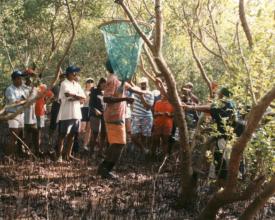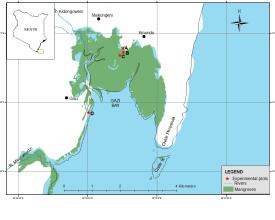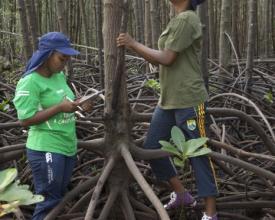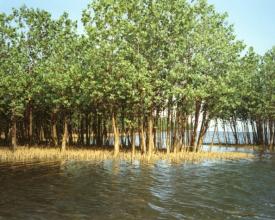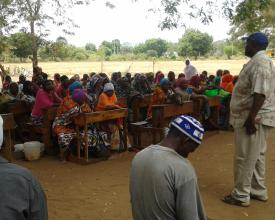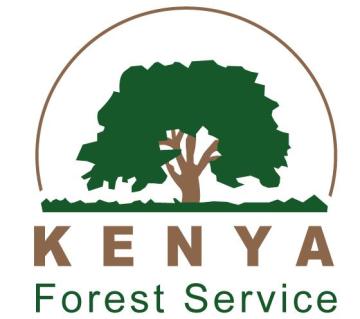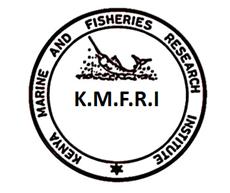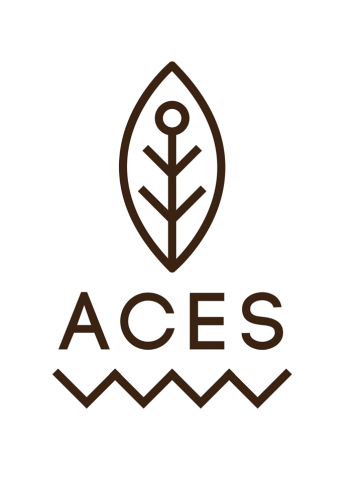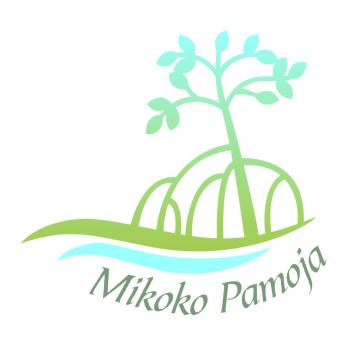
Blue carbon credits financing community-based mangrove management
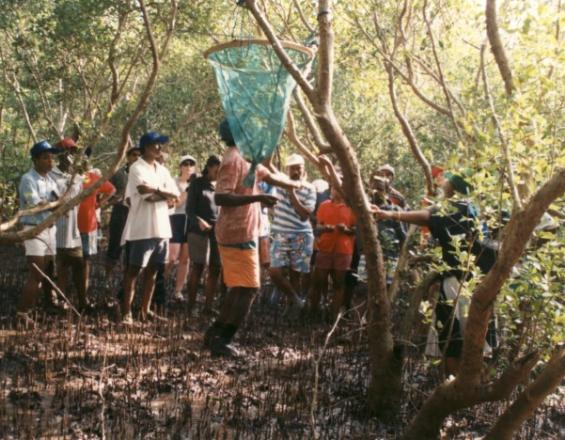
This is the first community-run project of its kind in the world: Mikoko Pamoja promotes the restoration and protection of mangrove forests for local community benefit. It is validated by Plan Vivo to generate and sell mangrove carbon credits to companies and individuals, who would like to improve their green credentials. The revenue generated from the trading of carbon credits flows into a community benefit fund, which is managed by the community-led Mikoko Pamoja steering group. The fund supports local development projects in education, water and sanitation, and mangrove reforestation.
Context
Challenges addressed
- Exploitation of mangroves for their wood and other products
- Losses of mangroves have negative effects on fisheries, resource sustainability and ecosystem integrity
- Degradation of mangroves leads to increased emissions of green house gases
Location
Process
Summary of the process
Due to the high emissions from the forest sector, the UNFCCC developed carbon conservation incentive schemes to enable financial compensations for good forest management. For communities in Kenya to earn funds through carbon projects, necessary legislation has to be in place. The Forest Act (2005) enabled the formation of Community Forest Association (CFA) at Gazi Bay, which was followed by the signing of a forest management agreement between Kenya Forest Service (KFS) and the community. The management agreement stipulates the allocable community activities in the forests and enabled the Mikoko Pamoja Community Organization (MPCO) to engage in the sale of carbon credits. The agreement provided an ownership of a designated area of mangroves of Gazi Bay to MPCO (approx. 117 ha) in which various project activities, including community education and awareness programs, are carried out. The collaboration with the Kenya Marine and Fisheries Research Institute (KMFRI) provided the necessary technical know-how needed for the carbon assessments and development of reference emission levels.
Building Blocks
Participatory Forest Management Plan
For a community to participate in the management of state forests (such as mangroves), it needs to sign a forest management agreement (FMA) with the government agency in charge of the sector, in this case the Kenya Forest Service (KFS). Signing of FMA is preceded by the formation of Community Forest Association (CFA) and the development of a Participatory Forest Management Plan (PFMP) for the area. As the name implies, developing the plan is a participatory process whereby views and concerns from different stakeholders are collected and analyzed. The final Management Plan includes a zonation map showing activities of different stakeholders in the designated forest area. The Participatory Forest Management Plan becomes operational once the Director of the Kenya Forest Service, the state agency in charge of forest management in Kenya, has approved it. The Plan for Mikoko Pamoja was approved in May 2013, followed by the signing of the forest management agreement in October 2013.
Enabling factors
- Enhanced community education and awareness on the values of mangroves goods and services.
- Increased threats of mangrove resources from deforestation and forest degradation.
- Community willingness to co-manage mangrove forests with the government.
- Establishment of a community forest association in Gazi.
- Strong support from government, private sector, NGO, and research organization.
- A clear zoning plan for each of the user group within the CFA.
Lesson learned
- Development of a participatory forest management plan should be a transparent and an all-inclusive activity.
- The process is time consuming particularly when you have to consider divergent views.
- Planning is a dynamic process; it is therefore easier to build a consensus as soon as possible and provide room for future changes.
- Community buy-in of the management planning process is critical for its full implementation.
- Resources need to be allocated to the development of the forest management plan, as it can be quite an expensive process. The cost of developing a PFMP for Gazi Bay was estimated at US$ 30,000; much of which went to community negotiations and capacity building.
Forest Management Agreement
The Forest Management Agreement is a legal tool between the Community Forest Association (CFA) and Kenya Forest Service (KFS) for the implementation of the Participatory Forest Management Plan, which only becomes effective after the signing of a the Agreement. This agreement officially secures community ownership of carbon credits and thus, is a prerequisite for a successful carbon project.
In short, the Forest Management Agreement is the vehicle to operationalize the Participatory Forest Management Plan.
Enabling factors
- The process is anchored in national laws, Forest Act (2005)
- Community understanding of the values of mangroves goods and services
- Willingness of the community to participate in joint mangrove management with the government
- Registration of a community forest association (CFA)
- Approved participatory forest management plan for the forest ecosystem
Lesson learned
- Consensus building is needed before the signing of forest management agreement between the government and the local community
- The agreement affirms community ownership of a designated forest area thus enhancing their participation
- Mangrove management needs to be pursued in an integrated manner; rather than over-emphasizing carbon benefits in the expense of other goods and services derived from the system
- Forest management agreement should be in simple language that is fully understandable by the community
Carbon know-how through strong partnership
Carbon-offset initiatives require a strong scientific basis to determine carbon stocks and baselines. Mikoko Pamoja benefits from a strong partnership with the Kenya Marine and Fisheries Research Institute (KMFRI) that conducted research to deliver necessary baseline data for the carbon offset project.
KMFRI now provides technical support during the implementation of Mikoko Pamoja. A member of KMFRI seats in the Mikoko Pamoja steering committee in order to report on monitoring results. An annual report is then submitted to Plan Vivo Organization detailing project activities undertaken. KMFRI’s position is critical in determining the accuracy of the information submitted to Plan Vivo.
Enabling factors
- KMFRI's strong presence in the project site Gazi Bay: The Institute has been working in mangrove research since the 1980s and has a field station in Gazi village
- Strong technical know-how and long-term involvement with national and international networks (Earthwatch Institute, International Blue Carbon Scientific Working Group)
- Resident permanent staff and students at the KMFRI Gazi station
- Strong partnership with the local community during development and implementation of mangrove activities
Lesson learned
- Carbon-offset initiatives require a strong scientific basis to determine carbon stocks and baselines
- Good relationship between scientists, government agencies, and communities is required for project sustainability
- Transparency is required in all stages of carbon project development. This ensures that there are no over-expectations among the community even when the carbon prices fluctuate
- Benefit sharing has to be pre-determined during the project development phase. This ensures onward harmony among project partners
- The strong partnership between KMFRI and Gazi community has enabled quick realization of carbon benefits
- Mikoko Pamoja has local and international partners such as Earthwatch Institute (UK), Napier Edinburgh University (Scotland), who have played a pivotal role in linking community to carbon buyers
Community environmental education and awareness
To promote awareness and a general understanding of the local and global significance of mangrove ecosystem to the Gazi Bay community, various stakeholder engagement forums were held during the inception, development, and implementation of the project. Engagements involved organizing village level meetings in which the Mikoko Pamoja team made detailed presentations on values of mangrove ecosystem, threats, and potential mitigation measures. The team also introduced the concept of carbon financing, its benefits to people and the environment, and sought community support. In addition, the team held a series of focus group discussions to get more insights on the community' perceptions and attitudes towards conservation and management of mangrove resources. These meetings have cumulatively built confidence between the community, government and the Mikoko Pamoja team. This is further grounded by the annual sales of carbon credits sequestered by the mangroves.
Enabling factors
- Presence of a structured leadership in the participating villages whereby the chair of the village has his own team that foresees governance of community affairs
- Transparency in service delivery: all group activities are publicized in community noticeboards strategically located in the villages
- Demonstrable benefits of the carbon project
- Support to community projects with income from the sale of carbon credits, including water and sanitation, education and environment conservation
Lesson learned
- The concept and technical aspects of carbon trading are difficult for some community members to grasp
- Finding consensus on benefit sharing is always challenging
- The fluctuating prices of global carbon credits are negatively impacting the community morale to sustainably manage mangrove resources in their areas
- There is an urgent need to enhance community education and awareness beyond mangrove forest carbon and instead the entire mangrove ecosystem services, such as fishery and shoreline protection functions
- There is a great need to develop strategies for rehabilitation of degraded mangrove areas outside the Mikoko Pamoja sites
Impacts
Through Mikoko Pamoja, the community has a powerful mechanism to generate revenue, which is benefiting community projects in health, education and mangrove management. Restoration efforts of lost mangrove areas increase the amount of carbon that can be stored and together with the enhanced restoration and protection of mangroves a total emission reduction of 50,000t CO2 is expected over the next 20 years crediting period. In addition, healthy mangroves are nursery grounds for fish, ensure shoreline protection and support sediment stabilization. As the project has a strong ownership by the local community it also leads to improved education standards and enhanced awareness for the importance of healthy mangroves among the community. The success of Mikoko Pamoja is being replicated in Kenya’s south coast at Vanga and across the Western Indian Ocean countries in Madagascar, Tanzania and Mozambique.
Beneficiaries
- The local community at Gazi Bay
- The Mikoko Pamoja Community Organization (MPCO)
- The Kenya Forest Service (KFS)
Sustainable Development Goals
Story
Mikoko Pamoja is all about the community living in harmony with a natural mangrove environment. It is the first ever community-type forest to trade and benefit from sales of mangrove carbon credits. Some of the poorest people on earth rely on the mangrove forests that fringe the Kenyan coast. Bridging the sea and land, mangrove trees provide storm protection, feeding grounds and nurseries for fish, as well as harvestable wood products, such as firewood. And mangroves offer another service to the globe: even more than terrestrial forests, they fight climate change by sucking carbon out of the air and storing it safely underground. The capacity of mangrove to capture and store carbon has been estimated at 3-5 times higher than any productive terrestrial forest. However, 30–50 per cent of all mangroves globally have been cut down or burnt in the past half-century, placing them among the earth’s most threatened ecosystems. Considering the value of these coastal forests, their continuing destruction is one of the world’s great market failures. Centered in southern Kenya’s Gazi Bay, researchers have explored new ways to demonstrate the mangroves’ worth and tap their carbon storage potential to benefit poor coastal communities. Earlier work in Gazi Bay, led by James Kairo of the Kenya Marine and Fisheries Research Institute and Mark Huxham of Edinburgh Napier University, demonstrated how to restore cleared mangrove stands — even in areas where salty stumps have stood lifeless for 40 years. Now, the team is collaborating with an international ‘carbon credit’ scheme to sell the carbon storage created through mangrove reforestation and conservation. Small, community based projects — in Kenya and worldwide — could fit into the UN’s programme for reducing emissions from deforestation and forest degradation (REDD). Researchers and Kenyan forest managers are discussing steps to turn vulnerable mangroves into profitable REDD sites. Using lessons from Gazi Bay, many more communities could reap increasing value from healthy coastal forests. The success of Mikoko Pamoja is being replicated in other parts of Kenyas coast and the Western Indian Ocean region.
